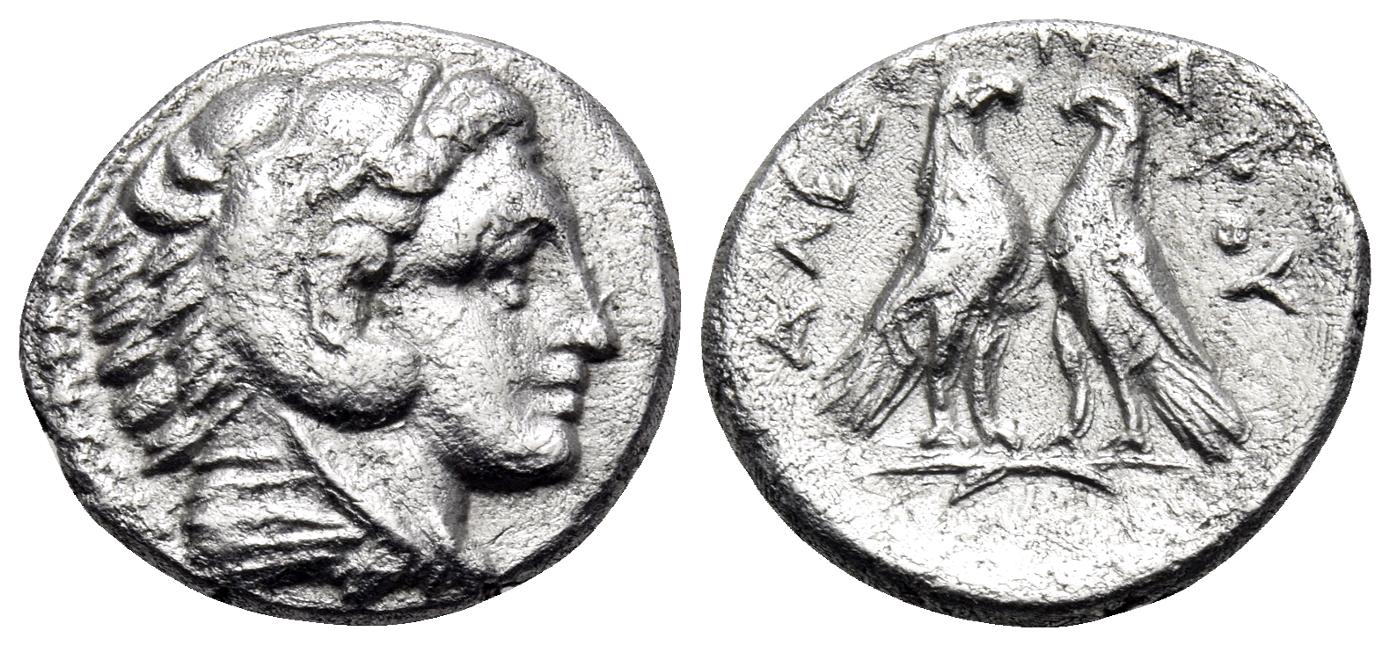S 1700 - Amphipolis (Alexander the Great), silver, diobols (332-310 BCE)
From SILVER
332 BCE - 310 BCE Silver 522 kg
Description
| ObverseInscription or printing placed on the obverse.: | Head of youthful Herakles in lion's skin headdress to right |
| ReverseInscription or printing placed on the reverse.: | ΑΛΕΞΑ-Ν-ΔΡΟΥ (Greek).Two eagles, both with closed wings, standing facing each other on a thunderbolt |
Mint and issuing power
| MintIdentifies the place of manufacture or issue of a numismatic object.: | Amphipolis | Ancient regionAncient region.: | Macedon | Modern countryModern country: Greece | AuthorityIdentifies the issuing power. The authority can be "pretended" when the name or the portrait of X is on the coin but he/she was not the issuing power. It can also be "uncertain" when there is no mention of X on the coin but he/she was the issuing power according to the historical sources: | Alexander III the Great (Argead king, 336-323 BC) |
Chronology
| FromIdentifies the initial date in a range assigned in a numismatic context. | 332 BCE | toIdentifies the final date in a range assigned in a numismatic context.. | 310 BCE | PeriodTime period of the numismatic object.: Hellenistic 323-30 BC |
Physical description
| MetalThe physical material (usually metal) from which an object is made.: | Silver |
Median weightMedian of the weights of numismatic objects (in grams). in grams | 1.40 | DenominationTerm indicating the value of a numismatic object. Examples: tetradrachm, chalkous, denarius.: | diobol |
StandardStandard.: |
Image

S1700 Amphipolis Alexander diobol.jpg [1]
References
| Die study referencePublication of the study: | Troxell 19971Troxell 1997, p. 33-34 | ||
| Coin series referenceReference to coin series study: | Price 19912Price 1991, n° 155 | ||
Obverse dies distribution
no distribution is available
Reverse dies distribution
no distribution is available
Quantification
| Number of obversesNumber of obverse dies. ᵖ (o) | 13 | Number of singletons (o1)The number of singleton coins. ᵖ | |
| Number of reverse diesNumber of reverse dies. (r) | Number of coinsNumber of coins. (n) | 31 | |
| Coins per obverse dieNumber of coins per obverse die. (n/o) | 2.38 | Coins per reverse dieNumber of coins per reverse die. (n/r) | |
| Reverse per obverse ratioRatio of obverse dies divided by reverse dies. (r/o) | Percentage of singletons (o1)number of coins (n) divided by the number of singletons (o1) ᵖ | % | |
| Original number of dies (O) (Carter 1983 formula)The estimation of the number of coins according to Carter 1983 ᵖ | 18.63 | Coins struck if 20,000 as average productivity per dieCoins made if the average productivity for obverses (according to Carter) is 20,000. ᵖ | 372,600 |
| Original number of dies (O) (Esty 2011 formula)The estimation of the number of coins according to the singleton formula in Esty 2011 ᵖ (O) | 22.39 | Survival rate if 20,000 as average productivity per dieSurvival rate if average productivity is 20,000. ᵖ | 0.00008 |
| Coverage (o = % of O) (Esty 1984 formula)Esty 1984 - coverage (% of O) ᵖ (o = % of O) | % | Die productivity if survival rate 1/2,000Average productivity if survival rate is 1/2,000. ᵖ | 3,327.97 |
| Weight of silver (in kg) if 20,000 coins per die (O = Carter formula)Carter 1983 * Median weight * 20000 (*10 if gold or electrum) ᵖ | 522 kg <br /> 522 kg | Die productivity if survival rate 1/5,000Average productivity if survival rate is 1/5,000. ᵖ | 8,319.91 |
Remarks
References
- ^ Troxell, Hyla A. (1997), Studies in the Macedonian Coinage of Alexander the Great, Numismatic Studies 21, New York, 161 p., 31 pl.
- ^ Price, Martin Jessop (1991), The Coinage in the Name of Alexander the Great and Philip Arrhidaeus: a British Museum Catalogue, 2 vol., Zürich-London, 637 p., 637 p., clix pl.